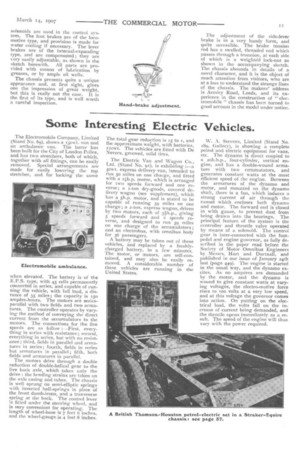Some Interesting Electric Vehicles.
Page 11

If you've noticed an error in this article please click here to report it so we can fix it.
The Electromobile Company, Limited (Stand No. 69), shows a iscwt. van and an ambulance van. The latter has been built for the City of London Police, and has two stretchers, both of which, together with all fittings, can be easily removed. Special arrangements are made for easily lowering the top stretcher, and for locking the same
when elevated. The battery is of the E.P.S. type, with 45 cells permanently connected in series, and capable of running the vehicle, with full load, a distance of 35 miles; the capacity is 150 arnOre-hours, The motors are seriesparallel with two fields and two armatures. The controller operates by varying the method of conveying the direct current from the accumulators to the motors, The connections for the five speeds are as follow :--First, everything in series with resistance; second, everything in series, but with no resistance; third, fields in parallel and armatures in series ; fourth, fields in series but armatures in parallel ; fifth, both fields and armatures in parallel.
The motors drive through a double reduction of double-helical gear to the live back axle, which takes only the drive the bending strains are taken on the axle casing and tubes. The chassis is well sprung on semi-elliptic springs with inverted half-springs in place of the front dumb-irons, and a transverse spring at the back. The control lever is fitted under the steering wheel, and is very convenient for operating. The length of wheel-base is 7 feet 6 inches, and the wheel-gauge is 4 feet 6 inches. The total gear reduction is 15 to 2., and the approximate weight, with batteries, 21cwt. The vehicles are fitted with De Nevers, grooved, solid tires.
The Electric Van and Wagon Co., Ltd. (Stand No. 91), is exhibiting :—a scwt. express delivery van, intended to run 5o miles on one chacge, and fitted with a 201.p. motor, which is arranged for two speeds forward and one reverse ; a t-ton dry-goods, covered delivery wagon (see supplement), which has a h.p. motor, and is stated to be capable of running 59 miles on one charge; a 2-ton, express wagon, driven by two motors, each of 3ih.p., giving 5 speeds forward and 2 speeds reverse, and designed to run 59 miles on one charge of the accumulators ; and an electrobus, with omnibus body for 36 passengers.
A battery may be taken out of these vehicles, and replaced by a freshlycharged battery, in a few minutes. The motor, or motors, are self-contained, and may also be easily removed. A considerable number of these vehicles are running in the United States.
W. A. Stevens, Limited (Stand No. 189, Gallery), is showing a complete petrol and electric equipment for vans, etc. The dynamo is direct coupled to a 2ob.h.p., four-cylinder, vertical engine, and has a double-wound armature with two commutators, and generates constant watts at the most efficient speed of the engine. Between the armatures of the dynamo and motor, and mounted on the dynamo shaft, there is a fan, which induces a strong current of air through the • tunnel which encloses both dynamo and motor. The forward end is closed in with gauze, to prevent dust from being drawn into the bearings. The principal feature of the system is the controller and throttle valve operated by means of a solenoid. The control gear is inter-connected with the f ootpedal and engine governor, as fully described in the paper read before the Society of Motor Omnibus Engineers by Messrs. Hart and Durtnall, and published in our issue of January 24th last (Page 449). The engine is started in the usual way, and the dynamo excites. As no airipres are demanded by the motor, and the dynamo is wound to give constant watts at varying voltages, the electro-motive force rises to TOO volts at a very low speed,
and at this voltage the governor comes into action. On putting on the elec trical load, the volts fall on the increase of current being demanded, and the throttle opens immediately as a result. The speed of the engine will thus vary with the power required.
































































